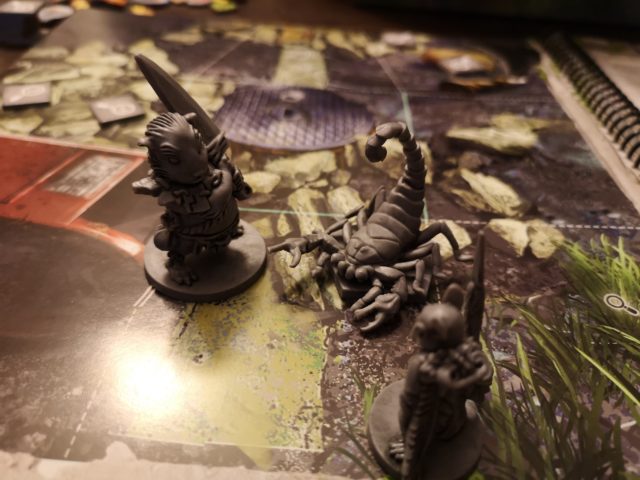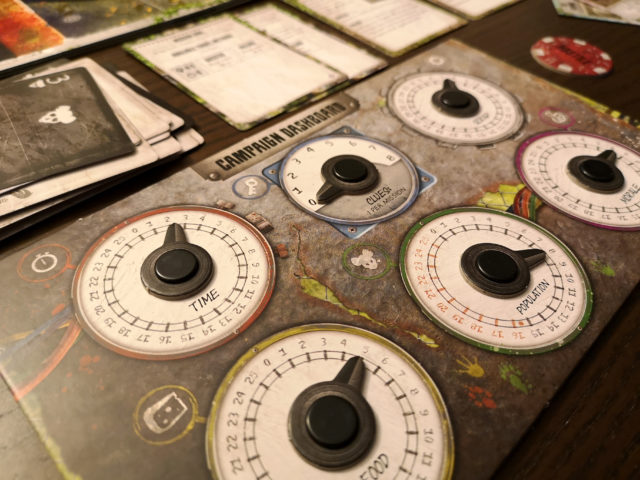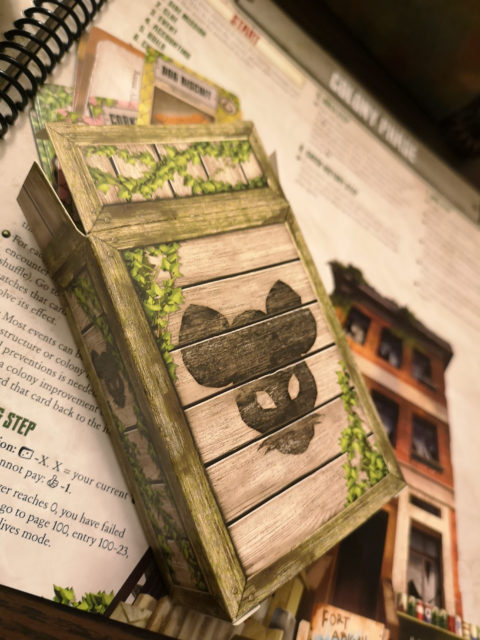Since Mice & Mystics first hit our tables in 2012, designer Jerry Hawthorne has followed up with a number of truly interesting “Adventure Book” games, inspired by and building on what M&M first offered. Although it’s been a good long while since I’d played M&M, I have given Stuffed Fables a play in recent times (and David and I shared our thoughts). I was not expecting to see another Adventure Book game with this much content out so soon, but Aftermath is now out in the wild with all its post-apocalyptic cuteness. Rather than the fantasy rodent setting of M&M, Aftermath instead presents players with a number of sentient rodents living in a post-human world. Roaming through the remnants of a larger society and coming up against foes, this campaign game is built to give you a good story time. (And I will let you know, there are no spoilers here for the story!)

Like many adventure games, Aftermath provides players with a good “tutorial” scenario as their first, giving the players an extra hand with how to proceed through the steps of everyone’s turn and various outcomes. I appreciated this, as it was good to reinforce the rules during play. I did, however, stumble a little on subsequent games if there was a little time between plays. To avoid this, I’d make the effort to familiarize yourself with the various components, decks and the layout of card types. Make sure you understand the rules for little details (for example, an opposed skill check in combat versus a normal one during a scenario, or what happens when you move to another page etc.) because this will mean each game plays smoothly, rather than having to reference rules too often. There is a good summary on the back page of the rulebook that is handy to have by that should be enough otherwise, which I always like to see. Never assume your players can get by without a handy reference.
So, without going into the story elements, I’ll give you my overall impression after that tutorial and a few subsequent scenarios. Firstly, although I’d seen there was a “colony deck” mentioned I wasn’t sure what that meant exactly. When the tutorial ended and the results were read in the adventure book, we were then directed to the “colony phase” – a part of the campaign play that lets you make improvements to your group’s set up, equipment and resources, and repair items. Cards that will go forward with you are then put in a colony deck box – and this is one of the best new elements I’ve seen in a campaign game, to be honest. It removes the confusion of trying to put cards and whatnot aside to bring out next game; not only that, there is a banished card deck box so you don’t have to destroy anything, but cards that are no longer needed will be kept out of your way.

Not only are there campaign and game-specific elements that carry on from game to game, but each character will be put away in its own deck box, along with any items they’ve gathered during the progression of the story. As well as this, each character will have a goal that is tied to colony development – I love this! It enriches the character of each of these little critters and gives them a unique place in the story. The campaign elements and the saving in deck boxes makes this a much easier flow of play from game to game, unllike other campaign or legacy games I’ve experienced. It’s a huge boon! In some ways, it feels like an automated D&D adventure, complete with character progression and awesome maps and minis. The Adventure Book system removes the need for a DM, meaning everyone plays co-operatively “against” the game, and has enough variety within the content that you’re not feeling like you’re repeating yourself.
Every game consists of a main mission, and a side mission, which you collectively pick from the mission cards available to you (so far). I like that there’s a decent variety of goals right out of the box instead of a basic “go from point A to point B and then return with item C” sort of adventure. You may be wanting to track around maps to gain resources, or find allies, for instance! No matter what, you’ll be travelling along based on the “area map”, which will take you through various pages in the book as well as encounters. So, rather than going straight to where you’ll need to act on your main or side mission, you’ll be heading out through all sorts of territories where you’ll come up against automated encounters (sometimes random, sometimes completely related to a mission and seeded near the top of the encounter deck). This again has the feel of D&D where players don’t just get to hand-wave travelling, but will more than likely end up having randomly generated encounters along the way.
I’ve mentioned a number of decks so far, and as I mentioned – familiarize yourself with them! They’re the driving force of much of your campaign, along with maps and adventure text in the book. There are some sorts of things I’ve encountered in other games, such as item cards and environmental condition cards, but I did like the use of “status cards” which allowed characters to take on effects from combat or the environment – much more interesting than a simple “take damage, next” encounter. I think I was most impressed with the action cards and how they drive players to make certain choices, and also the spawning and activation of enemies that comes out of drawing from this deck.

Players will draw up to 5 of these action cards at the start of their turn – they can be used to perform skill checks, move, and for combat. They’re mostly number cards of colours (corresponding to skill checks), but there is one “calamity” card that could put characters in danger depending on how long they’ve been on their mission. A few are “threat cards” that are then placed along the threat track which is where encounters may be triggered, or enemies will be activated depending on if you’re in a safe or hostile situation. It’s a clever way of wrapping up this activation (if there’s equal to or more threat cards than enemy cards) and also defining the action that enemies will perform (based on the number on the threat card, corresponding to certain actions on the enemy card). This really takes the difficulty out of what could be a tricky way to run combat, and it’s nice and straightforward.
I must say, the art certainly intrigues me. It lies somewhere between Mice & Mystics and Dead of Winter – some gritty environments and scary adversaries, but also cute as heck characters. As a fan of fiction such as Watership Down and the Secret of Nimh, I love the way this art brings to life sentient animals living in a larger, human world. The sculpts of all of the minis – characters and enemies – are top-notch as always (as I’ve come to expect especially after Stuffed Fables), so if you’re a miniature-painting gamer you’re in for a treat. There are, of course, a lot more miniatures than I’ve even scratched the surface of as far as encounters that my team had in the first 3 – 4 missions.

And that brings me to my final point. There is an enormous amount of content in this box. Every game dips into a little bit of it, but as you progress and access the Discovery deck more and build up your colony, it will start to feel like a robust setting. You will go in with the feeling of exploration and will not be disappointed – and you’ll have plenty ahead of you to whet your appetite. Those of you keen for adventure but aren’t looking to commit to a regular RPG campaign will find a lot here – I can’t say that I would want to play the game removed from the story, either, which speaks to the quality of the narrative that’s been created for this setting. I am keen on playing further to see what personal goals I can achieve for characters to really find that story satisfaction. I hope you enjoy digging into this great family-weight co-op.
—
Aftermath is a co-operative Adventure Book campaign game for 1 – 4 hours, taking approximately 60 – 120 minutes per session. Designed by Jerry Hawthorne, with art by Tregis & Jimmy Xia, it is published by Plaid Hat Games. Thank you to the PHG family for sending a copy of this game along for us to review.
Comments
No comments yet! Be the first!